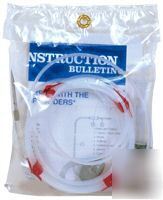DO NOT SCRAP IT! MODERATED NATIONAL EXCHANGE NEWSGROUP FOR SALVAGERS > Louisiana
> New nu-calgon drip feeder no.1075**** lot of 5**********
New nu-calgon drip feeder no.1075**** lot of 5**********
New nu-calgon drip feeder no.1075**** lot of 5**********
Nu-Calgon Drip Feeders No. 1075
Used for feeding the same chemicals as the No. 215 Drip Feeder except that the flow rate is 5 times greater. Generally recommended for systems larger than 60 tons.
1. Determine how many bottles of treatment are needed and how high above the sump water the bottles must be placed to get the desired Head.
2. When using a 1-gallon feeding bottle, remove the notched plastic disc attached to the handle. Insert the disc under the bottle cap and tighten. If feeding from a 5-gallon pail, make or punch a small hole in the bottle neck or handle area to allow air to enter (some 5-gallon pails are molded with a capped nipple on the handle - remove cap and discard and puncture the nipple).
3. Utilize the jug holders for installing containers on towers or evaporative condensers. Use the C-284-1 for 1-gallon bottles and C-284-5 for 5-gallon pails. If the jug holders are unavailable, you may make or construct your own bracket; for 1-gallon bottles, you may use the coated wire included.
4. Place coil of capillary tubing over neck of bottle and secure it to the handle. This will prevent the probe from being pulled out of the bottle if an air current moves the Feeder around.
5. Make sure capillary tubing is inserted at least 3/8" into the sleeve attached to the prove so connection will not come apart. Then insert sharp tip of probe into lower part of bottle, about 1 inch above bottom.
6. Use the syringe to prime capillary tubing and start treatment feeding. Insert end of capillary into the small diameter soft tube on syringe. Pull plunger out past the "v" notch cut into the side of one of the plunger fins; this will create a suction on the liquid treatment. Slide purse clamp down the plunger barrel until it snaps into notch, and interlock ball ends of clamp. Maintain until treatment enters syringe. Unsnap purse clamp and remove it along the syringe. You may leave the syringe housing on capillary tubing if desired for protection of dripping end of tubing.
7. Make sure treatment is dripping from end of tubing. The dripping end may be in the water or out of the water.
8. The bottle of treatment chemical should be refilled before it is completely empty and air enters the Feeder. If air bubbles enter the tubing, it is difficult to re-prime the Feeder by applying suction with the syringe. To get air out of capillary tubing, refill feeding bottle with chemical, then fill syringe with water, hold upright and push plunger to get air out of syringe.
Connect syringe to tubing and force water in syringe through the tubing. Hold syringe and Feeder connection tightly and push plunger slowly. It takes a few minutes to force water through the tubing. Repeat with another syringe of water. Then draw 2 or 3 syringes of chemical out of bottle as described in item No. 6. Before leaving job, check end of tubing to be sure treatment is dripping properly.
When the cooling tower or evaporative condenser is enclosed with sheet metal, the following procedure should be used so that Feeder operation can be checked without removing panels from unit.
1. Hang bottle of treatment at desired height outside tower or evaporative condenser.
2. Drill a 3/8" hole in side of unit below bottom of treatment bottle and above level of sump water.
3. Insert a piece of 3/8" OD plastic tubing through the hole so that the end is submerged in the sump water.
4. Fasten outside end of 3/8" tubing to side of tower so that weighted end of Feeder goes into the 3/8" plastic tubing about 3 inches.
Temporary Email: chelseaowens@dontscrapit.com (Chelsea Owens)

